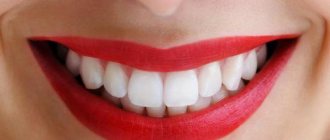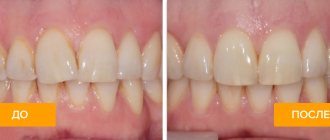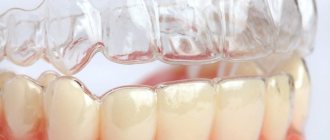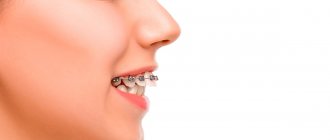Braces allow you to correct your bite not only for children, but also for adults. It is much easier for the younger generation to straighten their teeth and form a beautiful smile, since their jaws are still growing and their teeth move quite quickly. And children and teenagers have fewer problems getting used to braces.
Adults have to spend more time and make significant efforts to form an attractive set of teeth and finally begin to smile openly and without embarrassment. Therefore, very often, during a consultation with a dentist, patients who need a quick and inexpensive bite correction ask the question: “Is it possible to straighten teeth using metal-ceramics?”
Is it possible to correct a bite without orthodontic systems?
Orthodontic treatment is aimed at correcting serious deficiencies: straightening protruding or misaligned teeth, reducing interdental spaces, and ultimately correcting all types of malocclusions. To do this, braces change the position of teeth in three planes at once, simultaneously affecting bone tissue and dental ligaments.
Patients who do not want to spend a lot of time wearing braces can indeed undergo dental prosthetics in Moscow . At the same time, the attractiveness of the dentition will be restored, since the teeth will look even and beautiful, and the gaps between them will be hidden by dentures. But it will not be possible to eliminate all the consequences of an incorrect bite, since a denture does not allow changing the incorrect location of the tooth roots, and therefore does not eliminate the root cause of the anomaly.
In this case, it is more correct to talk not about bite correction with dentures, but about the prompt restoration of the natural dentition and the correction of its individual defects. There is a special name for the corresponding technologies in dentistry - microprosthetics.
Where is the best place to install implants?
The installation of implants should be carried out strictly after a preliminary examination by all specialists who should be involved in this complex process, computed tomography diagnostics, and the development of a treatment plan. When choosing a clinic to install implants, go to the dentistry where doctors use an integrated approach to dental treatment. This is the only way you will be insured against unexpected negative consequences of the treatment. This comprehensive approach to the treatment of each patient is carried out by highly qualified doctors at the German Es-Dent Center for Aesthetic Dentistry.
Veneers and inlays - modern types of dental prosthetics
A partial alternative to orthodontic structures can be elements made from high-tech ceramics, which allow:
- restore the integrity and functionality of the tooth;
- change its shape or “turn” around its axis;
- eliminate chips on its surface;
- visually reduce the large gap between the front teeth;
- restore the dentition when one or two teeth are lost (adhesive prosthetics).
The cost of microprosthetics is quite affordable, considering that along with the rapid restoration of the aesthetics of the dentition, the chewing ability of the teeth is also restored. Modern technologies make it possible to produce ceramic inlays and veneers that are indistinguishable in color and shape from the patient’s healthy teeth. Microprostheses are made by a dental technician using an individual impression, so they fit tightly to the surface of the teeth and have a long service life. It is also important that when microprosthetics is applied to a tooth, its healthy neighbors are not subjected to treatment and do not experience additional stress.
Quick appointment Free consultation
Diagnostics
Any treatment at Dial-Dent begins with a comprehensive diagnosis. This is an important stage, as it makes it possible to correctly draw up a treatment plan. This means 100% compliance with the timeframe and cost stated before treatment. Comprehensive diagnostics, including photographing the patient’s teeth, face and posture, taking impressions, making and analyzing plaster models of the jaws, OPTG and TRG images in the lateral projection, consultations with an orthopedist, orthodontist, neuromuscular dentist, osteopath, and psychologist, lasted two weeks. The cost of diagnostics was 20 thousand rubles. The main conclusion made by doctors after diagnosis is that orthodontic treatment and bite correction can be carried out without surgical intervention! The position of the lower jaw will be changed, but not surgically, but through a functional restructuring of the temporomandibular joints. Such treatment will give a stable result, the restructuring will take place gradually, the posture will have time to adapt to the new position of the lower jaw, in which an osteopath will provide indispensable assistance. The patient will avoid all risks of surgery.
Diagnosis by orthodontist O.A. Baranova: crowding of the frontal group of teeth of the lower dentition, rotation of tooth 3.3, oral position of tooth 3.4, narrowing and lengthening of the upper dentition, narrowing and shortening of the lower dentition, deep distal bite (skeletal form of the anomaly).
A neuromuscular dentist performed a diagnosis of muscle function and movement of the lower jaw.
Myography at rest before treatment. The functioning of the masticatory and sublingual muscles is impaired and there is an imbalance.
Load myography before treatment. Chronic fatigue of the masticatory muscles is observed.
Axiography of the movement of the lower jaw before treatment. The movement graph indicates a strong displacement of the lower jaw back, displacement of the disc of the temporomandibular joints. Rotation of the C1–C3 vertebrae (the first three cervical vertebrae) was diagnosed. The functioning of such organs and parts of the body as the inner and outer ear, brain, eyes, visual, auditory, facial nerves, temporal joints, and teeth depends on the correct position of these vertebrae. Symptoms of displacement of the first cervical vertebrae: headaches, high blood pressure, pain in the temporal joints, eye diseases, hearing loss, neuritis.
Using special equipment, the physiological position of the lower jaw was determined. This position will be fixed with special overlays on the teeth (orthotic). A non-removable orthotic installed on the teeth will help the muscles rebuild their work and secure the correct trajectory of movement of the lower jaw, in which there is no overload in the temporal joints.
Ceramic inlay - microinsert that replaces a filling
As you know, before filling a tooth affected by caries, the doctor first excises its non-viable tissue. Therefore, in case of secondary caries, when the filling has to be re-placed, due to the significant size of the cavity, the tooth is already practically destroyed. The patient is recommended to undergo depulpation and cover it with a crown.
Recurrence of caries occurs due to the lack of proper sealing between the walls of the tooth and the composite filling, which decreases in volume during polymerization. The ceramic inlay is free of this drawback; it is manufactured individually with high precision and therefore fits tightly to the tooth. The ceramic material of the inlay does not shrink and does not change color or shape during use.
Microprosthetics with inlays is performed on teeth whose defects make up up to 30% of the volume of their coronal part, and allows you to create exact copies of teeth with the correct shape of the chewing surface.
Treatment principle
Prosthetics can be performed if the following defects are detected in the oral cavity:
- Too noticeable gaps between teeth.
- Too large or, conversely, small sizes of individual units.
- Chips, cracks, breaks.
For minor defects, you can get by with the installation of veneers or lumineers. They are very thin plates that are made of composite or porcelain. They completely cover the front surface of their tooth. It is first necessary to grind the tooth, this will allow the veneer to look more natural.
Installing a crown allows you to solve a wider range of problems, while pathologies can be more pronounced. Most often, installation is recommended for very large lesions, when it comes to complete tooth extraction.
The following factors can lead to malocclusion:
- Too early loss of back molars or primary front teeth.
- Presence of bad habits (thumb sucking, pacifier or other objects).
- Loss of teeth due to health conditions or injury.
If the crown is placed in a timely manner, the risk of disruption of chewing functions and digestive problems will be minimized.
Purpose of crowns:
- Protection from more serious damage.
- Additional protection for implanted implants.
- They can come to the rescue if you receive a very severe injury, as well as with severe caries.
Stages of treatment
- To correct the bite using this method, the patient will need to visit the clinic at least twice. Stages: First of all, a detailed diagnosis will be carried out and tests will be taken. This will allow you to determine the general condition of the oral cavity and determine the course of further treatment.
- After the dentures or veneers are ready, a person needs to go to the dentist to fix them.
- Any further visits to the doctor may be necessary if discomfort or pain occurs.
Removable dentures
Also, to eliminate bite problems, you can use more budget-friendly treatment options - installing removable dentures.
Prosthetics are recommended in the following situations:
- Shortened and disproportionate lower teeth.
- The upper teeth overlap the lower jaw by more than a third.
- Impaired diction, inability to pronounce certain letters.
- Too much worn enamel.
- A noticeable protrusion of the upper or lower lip.
- Strong crunching or clicking sounds when chewing.
Removable dentures are an ideal solution for patients with complete or partial edentia. A complete removable denture is ideal for the upper jaw; it is firmly fixed due to the suction effect. In the lower jaw, it is recommended to save at least one of your teeth, on which a partial denture can be attached in the future.
Contraindications
In some cases, a patient may be denied prosthetics, for example, due to:
Strong contact of teeth with the prosthesis, as a result of which they can wear out even more.
Rapid wear of the prosthesis. This may cause too much pressure and uneven loading.
It is important to understand that there are quite a few contraindications to the installation of dentures to correct the bite:
- A very strong violation. In such cases, only surgery can help.
- The patient has serious diseases, for example, tuberculosis, HIV infection, cancer, etc.
- The presence of dental problems, for example, inflammatory processes in the oral cavity or severe caries. These pathologies are rather relative, but they must be eliminated before any further intervention. Otherwise, the situation may only get worse.
Veneers - surgical correction of tooth defects
When it is necessary in the shortest possible time to correct the position of a deployed, protruded or creeping onto an adjacent tooth, to eliminate the gap between teeth or to disguise extensive fillings, wedge-shaped defects and restorations, microprosthetics with veneers . A miniature, thin ceramic plate is also made from an impression and applied to the front surface of the tooth using a special adhesive composition. The surface of the veneer is indistinguishable from tooth enamel in color and other characteristics.
The possibility of dental treatment and prosthetics under general anesthesia allows you to restore the integrity of teeth with inlays and veneers with minimal discomfort for the patient.
Our specialists
Akhtanin Alexander Pavlovich
Orthopedic dentist, implantologist
Experience 35 years
Chief physician of the clinic, Implant Specialist (Boston, USA). He has been installing implants since 1996.
Akhtanin Evgeniy Alexandrovich
Dental surgeon, implantologist
13 years of implantation experience
Certified Straumann Young Professional. Member of the international association of implantologists ITI.
Akhtanin Alexander Alexandrovich
Orthopedic dentist, implantologist
10 years implantation experience
Member of the international association of implantologists ITI. Trained in Germany at the Charite University Clinic.
What consequences are possible?
In some cases, a specialist may refuse to correct a bite with braces due to certain complications:
- The material from which the crown is made may not withstand constant pressure and the outer layers may crumble or even completely.
- The root of the tooth may move in the wrong direction.
- After aligning the units, the artificial tooth may not look aesthetically pleasing.
Each case is individual, so the final decision on the installation of orthodontic structures is made by the doctor.
Stages of plastering models into an articulator
We continue diagnostics and conduct instrumental functional analysis. We install the models in anatomical relation to the skull and joint.
The upper jaw is transferred to the articulator along the kinematic arc of the condylograph. The lower jaw is plastered to the upper jaw in a centric relation.
Correction methods
The correction method is chosen by the orthodontist. He does this based on the results of an examination, which includes an X-ray or CT scan of the jaw.
Braces
Patients over 30 years old often think that at their age it is impossible to correct their bite with braces. Braces work at any age, but in mature jaws, correction of malocclusion occurs more slowly.
Another myth is discomfort while wearing braces. This is only partly true: the unpleasant sensations are temporary, occur after each activation, but quickly pass. As for the aesthetics of braces, modern people have long stopped perceiving them as something that spoils a person’s appearance. But even if the patient cannot overcome the constraint, partially or completely invisible systems are provided for him.
The average cost of braces is from 100 thousand rubles. This is the minimum price; this is usually what classic metal systems that are installed vestibularly cost. Plastic, ceramic and sapphire analogues are more expensive because they are hardly noticeable on the teeth.
Some of the most expensive systems are lingual. They are placed on the teeth from the tongue side, so they are invisible. But they are more difficult to activate and take longer to get used to. Braces are also distinguished by the type of correction:
- ligature (the arch is attached to the braces with ligatures - wires, rubber bands);
- self-ligating (a more modern and convenient fastening system - micro-locks).
During the consultation, the doctor will tell you all the differences and help you choose braces that are suitable for correction specifically for you.
Why it needs to be fixed
Correct teeth alignment provides the following benefits:
- clear diction;
- uniform distribution of chewing load on the teeth;
- chewing food thoroughly;
- normal tone of facial muscles.
Without the above, complexes develop against the background of speech problems (if the pathology provokes speech disorders). Due to improper distribution of the chewing load and poor chewing, diseases of the digestive system develop. Because teeth are crooked, their enamel can quickly wear away in specific areas. The accumulation of plaque and food particles in places that are difficult to reach for cleaning develops caries and bad breath.
Complex pathologies lead to serious changes in appearance. Such as chin distortion and early appearance of wrinkles. They can cause severe psychological discomfort.
Regarding fillings
Before placing orthodontic structures, the doctor must carry out full preparatory work, including a number of measures to prevent possible consequences. If there are any “holes,” they are filled with high-strength composite material. This rule is very important, since anything can happen in 1-2 years of treatment, because when wearing braces, pathogenic microorganisms multiply several times more actively.
If we are talking about old fillings that were installed several years ago, they must be replaced with new ones. During a period of long-term treatment, the filling may break, and installing a new one will be quite problematic.
We can conclude that each case is individual and requires specialist consultation. Due to many features, doctors recommend correcting the bite at an earlier age, in the absence of artificial structures in the oral cavity.
Prices for bite correction in Moscow
| Name | Cost, rub. |
| Installation of a vestibular metal brace system on one jaw (excluding the cost of equipment) Fixation of vestibular braces (metal, ceramic, sapphire, plastic) on one row of teeth (from the second molar to the second molar of the opposite side of the row of teeth). | 25,000 rub. |
| Installation of vestibular esthete. brace systems for one jaw (excluding the cost of equipment) Fixation of vestibular braces (metal, ceramic, sapphire, plastic) for one row of teeth (from the second molar to the second molar of the opposite side of the row of teeth). | 30,000 rub. |
| Installation of a lingual brace system on one jaw (without taking into account the cost of equipment) Fixation of lingual braces on one row of teeth (from the second molar to the second molar of the opposite side of the row of teeth). | 35,000 rub. |
- Prices in Moscow clinics
- Prices in clinics in Balashikha, microdistrict. Railway
Verticalization (raising the bite)
We carry out virtual modeling of bite elevation (VTO) in the Gamma program at 5 mm (meaning the incisal pin of the articulator). The initial bite height was 38.4 (values obtained when calculating the lateral TRG). After raising the bite we get a value of 40.8, which shows us that we are working in the adaptation zone (green area), and this is acceptable for this patient











